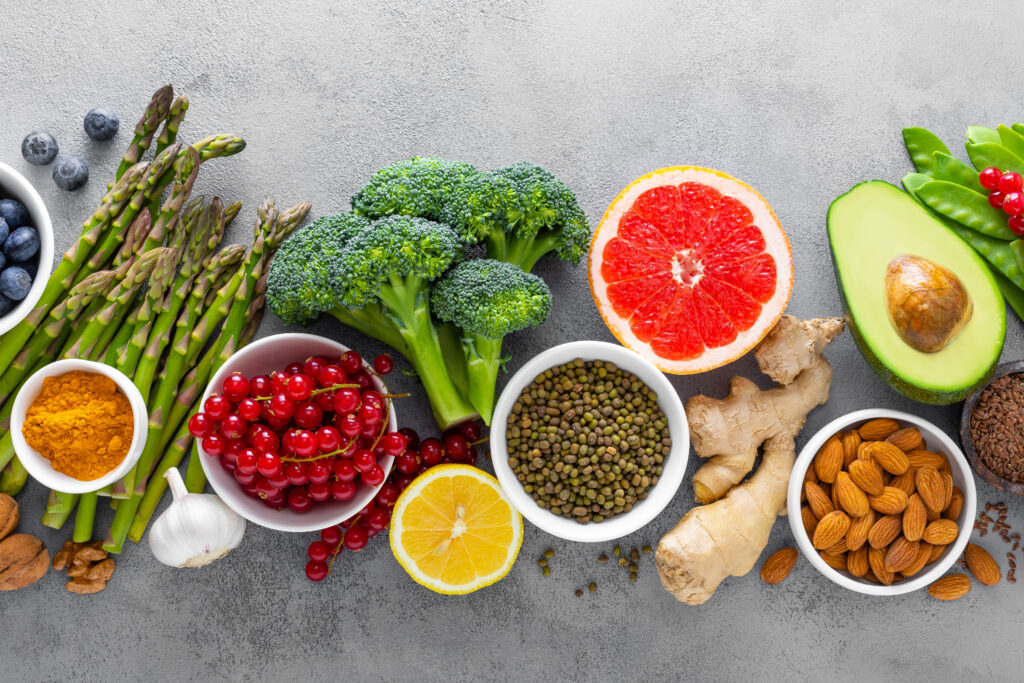Diet and nutrition trends come and go every few years or so. Some of the popular ones over the years include whole 30, keto diet, Atkins (low carb) diet, “if it fits your macros”, and intermittent fasting, just to name a few. There are also a large number people who have restrictive lifestyle choices based on moral beliefs or health reasons, such as veganism, vegetarian, or pescatarian. Most people choose to change their diets for health reasons, which is just as good a reason as any. In western culture, especially in the United States, obesity is a huge problem, and the vast majority of serious health risks can easily be linked to obesity.
Oftentimes, a person who studies yoga will also be introduced to a sister science called Ayurveda, originated from ancient spiritual texts of India. Translated to English, Ayurveda means the knowledge of life. According to this ancient science, food nourishes more than just our bodies. It also nourishes our minds, senses, and spirit on all levels. Our food is meant to be derived from nature and the act of eating is said to be our direct connection to Mother Nature’s energy. Health can be easily measured by proper digestion. It is the primary function of our digestive system to carry the nutrients from our food throughout our bodies. The science of Ayurveda is fairly complex. Entirely too complex to break it down in full understanding in just one article. This text will primarily be focused on food and its energetic qualities as related to proper digestion. Many people who suffer from obesity are accustomed to eating unhealthy foods that are difficult to digest. That is part of the problem
Digestion or destruction?
Depending on our energetic makeup, Ayurveda says that agni, or digestive fire, is the force that determines our metabolism or how quickly we break down the foods that we eat. This force also determines how effective our bodies absorb nutrients. Therefore, we are not what we eat. Instead, we are actually made up of what we are able to digest. Again, because of the food industry in the United States, a lot of Americans do not have a strong digestive fire. Shopping differently for your family can drastically change that. You don’t even need to jump in on the latest diet trend. Check out the information below to see how.
Before we talk about food qualities, let’s talk about ama. In ayurvedic texts, ama is defined as a sticky paste of whitish, yellowish color that has a rancid smell. This substance is toxic, and it literally gets lodged within our organs and different channels of our bodies as a result of poor digestion and toxic food choices. The texts also postulate that ama is one of our greatest health concerns, as the majority of health disorders can be linked to the presence of this matter in the body. If you have been primarily treated by Western medicine, be advised that there isn’t an exact equivalent of ama in Western medicine, but the closest known substance to compare it to would be cholesterol.
Ayurveda acknowledges the correlation between nature’s qualities and those that manifest within the mind and the body. Although these qualities (or essences) are such subtle energies, they rule the energetic blueprint and the mind of each individual person. The three essences are called Sattva, Rajas and Tamas. Each of these, sometimes called a guna, is always present in the mind. We can use our thoughts, actions, and food choices to influence the levels that these qualities are present within un.
Sattva, Rajas, and Tamas: The Three Qualities
Sattva:
The essence of Sattva symbolizes knowledge, purity, and light. This quality encourages stability and health, along with love, peace, and fulfillment. When working on creating and maintaining a sattvic lifestyle, you may find yourself connecting the dots of life’s bigger picture, releasing the lower desires of your ego. When operating from this quality, you cherish the simple things in life, finding materialism overrated and steering more in the direction of spiritual growth. A sattvic person seeks relationship with their higher power. By walking in our path with open hearts and increased awareness, we can bring more sattvic quality to our existence.
Sattvic foods are the purest and freshest foods that can be found. These foods are free from pesticides and chemicals, organically grown, and free of preservatives. Because it is easy for the body to digest sattvic food, eating these foods regularly creates a harmonious connection between the mind and the body. Sattvic foods usually are grown above ground, giving them a lighter quality. They are also frequently sweeter in taste, creating effects of rejuvenation on the body and calming effects on the mind. Examples of sattvic food include freshly grown fruits and vegetables, many types of lentils and beans, raw honey, sesame seeds and sunflower seeds, fresh cow’s milk, cashews, almonds, and walnuts. Consistency in consumption of these foods prevents disease and nurtures the mind, body, and spirit.
Rajas:
The essence of Rajas signifies activity, movement, and change. This quality elevates motivation and outward action. In many people today, the rajasic quality can be found in surplus, which leads to seeking happiness outside of self as well as increased mental heaviness. When operating from rajasic energy or essence, you may find yourself going after the pleasures that are short-lived, ultimately resulting in suffering and pain. If one pays attention to their own patterns, correcting this imbalance can be as simple as cultivating sattva through lifestyle and dietary choices.
Rajasic foods are said to be naturally stimulating. This quality is present in foods of various primary tastes including Salty, Pungent, Bitter and Sour. Examples of rajasic foods include tomatoes, peppers, garlic, pickles, avocado, onions, eggs, hot spices, salt, coffee, vinegar, lemons, and limes. If consumed moderately, these types of foods can stimulate the digestive fire and provide vital energy to the body. Excess consumption, however, can lead to jealousy, egotism, and anger. For this reason, it’s important to learn how to balance your diet between rajasic and sattvic foods.
Tamas:
The essence of Tamas is darkness, inertia, and dullness. This quality gives us the desire to slow down or stop for a rest. If this energy is present in excess, it will lead to attachment and depression as well as delusion and ignorance. When leading a tamasic lifestyle, it will be characterized by excessive sleep, lethargy, and lack of enthusiasm. This guna, or essence is the one that we need only in small doses. Build-up of mental and physical ama is a leading cause of a tamasic lifestyle. Foods that carry this energy should be minimized or completely avoided.
Tamasic foods are lifeless and dull. They are typically artificially processed foods that require canning, dry packaging or freezing. Because they are made up of so many unnatural ingredients and chemicals, these foods are difficult for the body to digest. This digestion issue leads to the formation of ama. Examples of tamasic food include deep-fried foods, frozen food, ice cream, leftovers, alcohol, meat and fish, and white sugar. Most Americans have diets that consist of primarily tamasic foods. If that resonates with you, you will notice a massive improvement in your overall health if you work on the balance of sattvic and rajasic foods while minimizing or eliminating tamasic foods. If that proves difficult, make small changes little by little. After a short amount of time, you’ll be able to feel that you really ARE what you eat.


